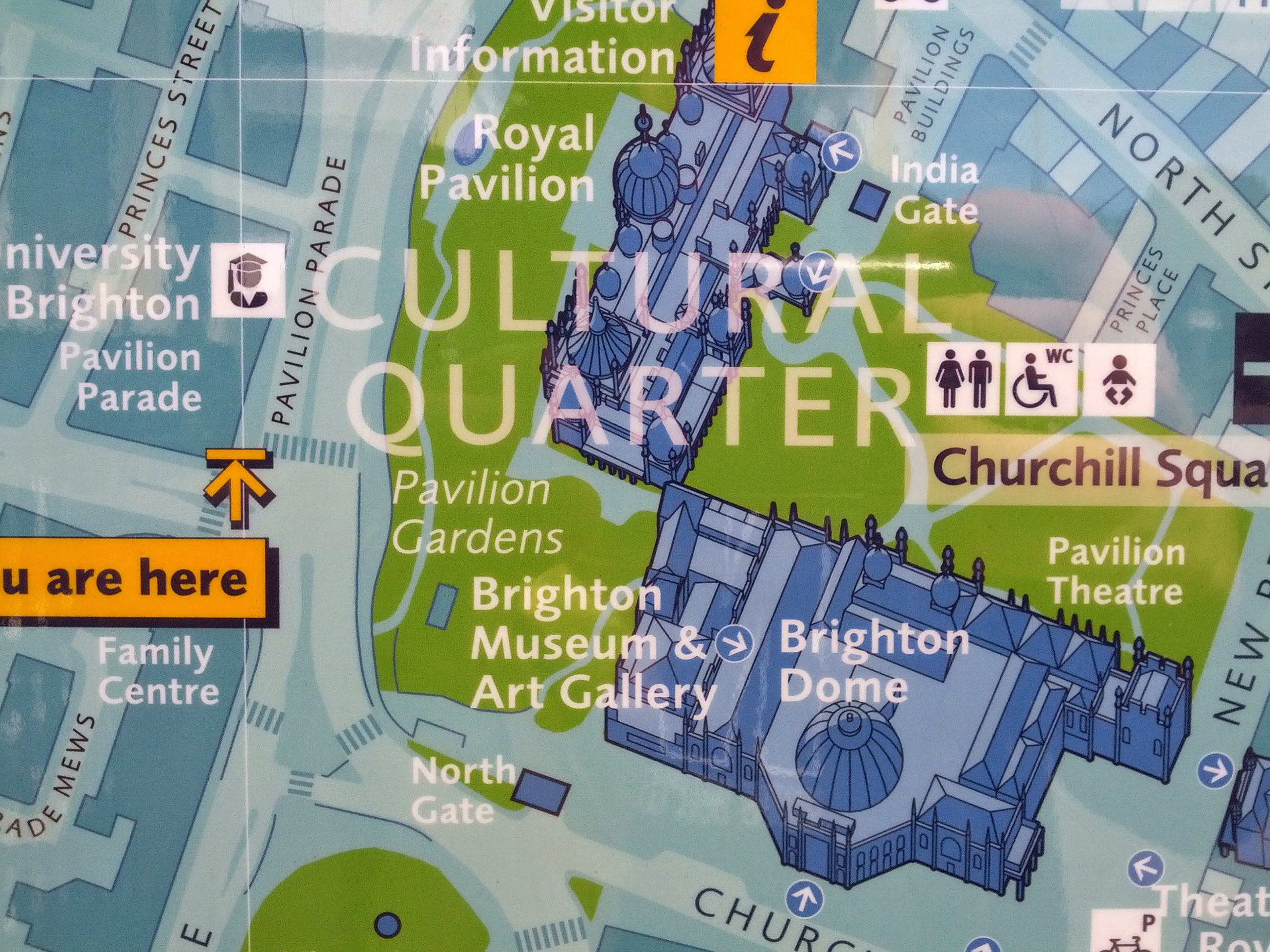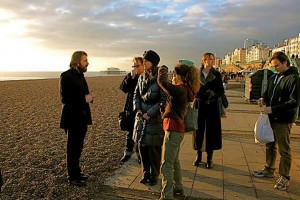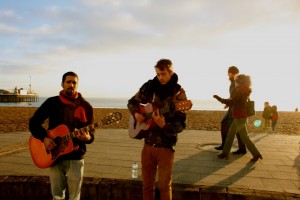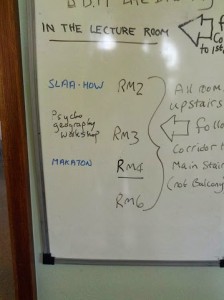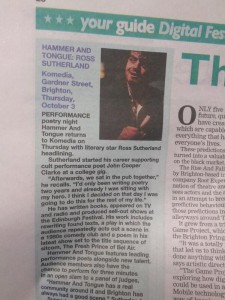“How dare someone tell me where the cultural quarter is? How dare anybody decide where culture can be found, or what it is, or how it can be safely packaged in a sanctioned part of the city” – from Ragworts by Bill Drummond
Category: Brighton
Psychogeography Workshop
On Saturday I ran a a two-hour psychogeography workshop. It was based on one I originally devised for Kate Shields‘ Ways of Seeing season, in May last year. My interest in psychogeography has been piqued recently, which led to running the session again.
This time we were based in the Friends Meeting House which was a great location, right in the centre of Brighton’s most historic area. I knew a lot of the participants but there were a couple of people I didn’t know, including one who was told about the course by a university tutor. One of the great things about events like this is meeting new people.
I gave a brief introduction to the subject before we went out in Brighton to try some experiments. We were very fortunate to have good weather, as I’d not prepared any alternative activities. One of these, pictured at the top of page, involved being the participants being blindfolded on the beach. Being Brighton, very few people paid it any notice, apart from one passer-by telling a friend that “it must be some sort of sex game“. Then, as I led my housemate, someone leaned over the promenade railings wearing a lion’s head. Brighton is a fantastic place for events like this one.
Teaching a subject is an excellent way of deepening your understanding of it. Some interesting questions were asked, particularly about the role of women in the subject. There were also some good ideas for activities to try in the future.
The session sold out and a lot of people who wanted to come couldn’t attend. I’ll run the workshop again in the Spring, possibly in an expanded form. Email me at james@orbific.com if you’d like me to send you details.
Seafront photos by sooxanne soox
i360: The Saga Drags On
I wrote most of this back in September, but it’s taken me a while to finish it off. I think it’s all still relevant.
The headline in Friday 20th September’s Argus was Hammer blow for i360 as private funding falls through. This referred to the latest chapter in the i360 story, with Brighton and Hove council debating whether to continue their support of the project in light of the latest collapse in funding.
The story’s opening paragraph was ambiguous: “The developer behind a £38 million tourist attraction said he had ‘no fears’ it will be delivered – despite the hammer blow of private funding falling through.” The article later expanded on this quote: “David Marks, who is behind the scheme, told The Argus he has ‘no fears’ over delivering it,” which is slightly clearer.
Planning permission was originally granted for the i360 in October 2006 and a series of proposed completion dates have swept by. The current plan is for the attraction to open some time in 2015. I’ve been following the sagas of the Brighton Wheel and the i360 for a few years now. I have no special insight into the topics involved beyond an ability to use Google. Any conclusions or predictions should be taken with a pinch of salt – I’ve previously told people, at length, how the Brighton Wheel was a ridiculous project with no chance of success.
The three main questions I had about the project were:
- Isn’t the annual visitor estimate of 800,000 people far too high?
- Why are the council lending £15 million to this project in the midst of appalling cuts?
- Why is the i360 continuing when it is a ridiculous project with no chance of success?
A lot of these questions are answered in greater detail in the documentation that comes with the i360 Loan Agreement, and my summaries are below.
Visitor Estimates
The commercial predictions for the i360 are based upon receiving 800,000 visitors in the first year. On the face of it, that estimate seems too high. The maximum capacity for the eye is 200 people. Each trip lasts twenty minutes, with the exception of the ‘Skybar’ evening rides, which will last 30 minutes. The expected visitor numbers average out at 2200 people per day.
At first this appears high, particularly given how poor trade at the Brighton Wheel seems to be. Some of the commenters on the Argus article have made similar calculations. But if the estimate is so bad that an Argus commenter can see the flaws, one would expect architects and councillors to figure that out too. The visitor estimates were run by AECOM Economics and their work is pretty sophisticated. Their report (included in the loan agreement) lists some of their previous visitor predictions and they seem to have done a good job.
The documentation with the Loan agreement explains that there will be 27 rides a day, averaged over the year (which actually seems a little high when the ride is open between 6 hours a day, Nov to Feb, and 12 hours a day, May-Aug – 27 twenty-minute rides will take up to 9 hours, excluding loading and unloading). This means an average of 81 people on each ride.
Looking at other attractions provides a good basis for these predictions. The London Eye has 3.5 million visits, with a peak of 4 million in 2003. 5 million people a year visit Brighton’s beach and the Pavilion receives 350k visitors. Apparently “if the Brighton i360 performed as well [as the London Eye, based on catchment area], this would mean it would achieve around 1.7m visitors a year”. If the i360’s performance is similar to that of the Spinnaker tower, which has underperformed, the project can apparently still make enough money to repay the council.
A sensible estimate is less interesting than the council supporting a project that makes no sense. The mundane truth is that the project ought to get the numbers estimated. I’m still baffled as to the attraction of the scenery visible from the i360 but if Blackpool Tower can get decent numbers for what is a truly boring view, Brighton’s i360 should do OK.
Project Funding
The main problem for the i360 is funding. The £38 million required is divided between public loans and private finance. The government has offered £3 million and the council are planning to take out a loan of £14 million which will then be loaned to the project. This loan is contingent upon sufficient private funding being available for the rest of the money.
Some people have asked why the council is lending a huge sum of money to a tourist attraction attraction when there are many other worthy causes. As the council’s website points out, “the government’s government’s strict guidelines mean we can only borrow to help commercial projects that make enough profit to more than cover these costs.”
The proposed private funding for the i360 fell through earlier this year, forcing the developers to go “back to the market”, but apparently nobody is willing to invest until the project is finished. As I understand it, the council has continued their support despite the setbacks meaning that the i360 saga will trundle on for a few more years.
Why is the project continuing?
My third question is why this saga is continuing. The reason for the council debate is that £20 million of private funding had fallen through with just weeks to go until the most recent start date. Despite this, the town hall has continued to support the project and continues to offer the loan, contingent upon sufficient private funding.
Discussing their loan guarantee, the council website reassures us “Bear in mind the investors signed up so far all think it’s viable – so does the government”. Which is somewhat contradicted by the continuing lack of substantial investment. But there are a lot of people with a lot invested in this project, people who have staked their reputations on it. The steel work for the tower has apparently already been made and is waiting to be moved to Brighton.
But the West Pier remains undeveloped, years after the project began. If this project isn’t going to happen, why can’t it be abandoned and someone else be given a chance? I don’t know the answer for sure, but a good comment was left below the Argus story by saveHOVE:
BHCC made a major mistake when its legal department deemed development to have started when a few bits sitting on the sea floor were picked up and cleared away by Marks Barfield people. It happened for 2 reasons:
1. It sent a message to the Brighton O applicants at the time that the space beside them was not available to help see that off and,
2. To prevent the time limit for use of their planning consent to expire. This is why we now suffer “planning blight” on that site which sees it stay as it is until forever.”
It was this removal of west pier ‘debris’ that sparked my interest in this issue. I loved the old ruins, how they would be revealed when the tide was low enough. I couldn’t see why they were removed in favour of a project that looked so unlikely. This theory gives some explanation – and we do have a series of retail developments due to open in the arches near the west pier. There is also the promise of “a new and thriving artisan quarter”. I’ll leave a rant on that to anyone who asks in person, but most of the artisans I know are crying out for cheap rent, not prestige developments..
In conclusion: the i360 seems to be a viable project, but nobody is willing to put money on the line for it.
Stand By for Tape Backup
Hammer and Tongue returns from its summer break on Thursday evening and we’ve got a very special night in store. Our headliner is Ross Sutherland who will perform the entirety of his new show, Stand By For Tape Backup.
Ross is probably my favourite poet (well, non-Brighton poet, anyway). I love his first collection, Things to do Before you Leave Town, which is published by the fantastic Penned in the Margins press – you should listen to the title poem now.
I saw Stand By For Tape Backup at Latitude in July. Ross used to watch TV with his grandfather and found an old video tape containing some of the shows they used to enjoy. As the video plays, Ross recites an amazing monologue, synchronising perfectly with the video. Among the films and shows excerpted are the Wizard of Oz, Thriller, and a lovely sequence on the true story of the Fresh Prince of Bel Air.
The show is one of the best pieces of spoken word I’ve ever seen and we’re very lucky to be able to have it at Hammer and Tongue. Doors open at 7:30pm in Brighton Komedia’s studio bar, entry £5. You must come!
2: Friends and other animals
Kate Shields! Night porter, night painter. For six months she has been working at the Artists Residence hotel, preparing her exhibition, Friends and other Animals. A true underground artist, working night shifts while holding sittings, Kate Shields! has finally emerged from her basement studio with a series of portraits of her friends including poet Chris Parkinson, aerialist Kitty Peels, model Frankie Cluney, and more.
The nocturnal portraits show some of the "curious and wonderful people" Kate has met in Brighton. They are painted onto wood and feature animals that Kate associates with the sitters.
It's been fun visiting Kate over the last few months and seeing the exhibition take shape. I was even there the weekend before the launch, helping Kate by drinking gin and writing while she put the worked on a painting. I'm not sure if I was much help and we drank so much gin that we felt a little poorly the next day.
The Private View on Thursday night was amazing. I met up with lots of old friends as well as meeting some fascinating strangers, including a neuroscientist and a chef who explained to me about the melting point of collagen. It was an exciting and educational night, supported by Hendricks Gin (although I was more careful this time). Here is a picture of me with Chris Parkinson, Brighton's Shadow Poet Laureate.
The exhibition runs until August 27th at the Artists Residence in Regency Square Brighton.
A Swenglish attempt on Mount Caburn
My friend, the Swedish writer Louise Halvardsson, has recently been working on her Swenglish project. This involves Louise spending a week with 30 different people, 15 in England and 15 in Sweden. As well as being a fascinating idea for an art project/alternative travel memoir, Lou is also hoping to decide whether to settle in England or Sweden at the end of it.
The project requires Lou to shadow her hosts for the full week, meaning that her free-time depends on what they want to do. This means that I’ve not seen much of Lou since I returned from my holidays, except on her weeks off. Since last week was a free week we met up and tried another of the Cheeky Walks, this one an expedition to climb Mount Caburn.
The weather wasn’t as good as my previous walk, but it was dry and the scenery was fantastic. Mount Caburn is an iron-age fort near Lewes and has some lovely views. Lou’s account of the walk is online in English and Swedish.
The directions on this walk weren’t quite as straightforward as the last one, and we managed to get lost around Glynde. Trying to get back to Mount Caburn we found ourselves on an obscure path that hit a dead end:
Signs of civilisation:
The notices about gorillas made us wonder if we were more lost than we thought:
Strange details in Lewes:
Muses on strike
On Saturday, Artists Models Ink held a protest in Pavilion Gardens. Their signs demanded 'Living Wages for Living Statues' and 'Arts Funding Cuts: We are not amused'. It was a fun event and fascinating to watch the reactions of passers-by, particularly Brighton's ubiquitous photographers.
The Singing Sculptures of Churchill Square
I've been in Brighton long enough to remember the old Churchill Square: concrete everywhere, with dingy corners like the one where the computer shop, Softcenter, skulked by the toilets. At the center was William Mitchell's sculpture, The Spirit of Brighton. A 30 foot high piece of concrete, it looked like a strange climbing wall. According to Timothy Carder, author of the Encyclopedia of Brighton, it was "intended purely as a 'piece of fun'.. but in reality it epitomises the dreadful concrete redevelopment of Brighton in the 1960s and 70s".
The old Churchill Square was opened in 1968 and the current center opened in the late 90's. It is hard for me to overlay the old version on top of the new one – there's something overwhelming about the new building, with its strange subterranean light. The Spirit of Brighton was demolished as part of the redevelopment.
Outside the new Churchill Square are two sculptures called The Twins. It was only recently that .scribe told me that this scuplture is interactive. According to the artist Charlie Hooker's website, "Sounds emanating from it, and images etched into its granite and bronze surfaces are derived from graphs produced by weather patterns specific to its location which were produced over the full year prior to the work's installation. The gentle sounds are produced by solar-controlled electronic devices which attatch to the bronze panels, causing them to produce sound. The piece is at its loudest on bright, sunny days".
One evening recently I stopped to listen to the sculptures. Putting my ear right up to the metal panels I could hear low tones. People notice when you listen to sculpture, and I saw one kid trying the same himself. I explained about the music but he shrugged. "I swear, I can't hear nothing," he said, and put his headphones back on.
A Cheeky Walk through Southease and Rodmell
The Cheeky Book of Walks was released last month and I only just got hold of my copy after sending it to the wrong address. On Sunday I set out with @vickymatthews and @booleandavid on the 'Suicide Stroll' a 5 mile circular route from Southease Station. The route passes Virginia Woolf's house and follows the walk she made on the way to take her own life.
It was a hot day and Sussex looked beautiful. I don't venture into the countryside as often as I should. And every time I take a rural walk I curse this fact and promise myself I'll do it more in the future. The Downs are so beautiful that I should make more of them.
My grandfather won prizes for his ploughing. I'm sure he would have done a better job than whoever ploughed this field:
In Rodmell village, opposite the Abergavenny Arms pub, is a small 'shrine' to Frank Dean. One of the posters lists his favourite sayings including "To justify spending money on oneself: there are no pockets in a shroud" and "Well blow me down, I'll go to Peacehaven in a rowing boat". It was a touching memorial.
I wondered why someone had nailed burlap sacks onto a wall. I found out from @MattPope on twitter: "repointed mortar on a wall repair. It must dry slowly or it'll turn to sand and blow away in the wind."
The route passed Monk's House, where Virginia Woolf once lived. According to our guidebook, the house was closed and the gardens only open on a Wednesday and Saturday afternoon. We were in luck, however, because this has changed since Cheeky Walks was printed – we could tour the gardens on a Sunday and also wander around the house.
A small display showed some of the visitors who had come to the house. Among the photos was one of EM Forster with TS Eliot. I would love to have had a chance to hear some of their conversations.
Resting under a tree in Virginia Woolf's garden, I felt incredibly relaxed. Vicky had bought some curried vegetable soup so we had a discreet picnic…
…then quickly washed up in the garden.
From Monk's House it is a short walk to the River Ouse, where Woolf took her life. The stretch of the Ouse near Southease is a scummy, brown, ugly river. I don't know what it was like in the 40s, but it seems a sad place for someone to die.
"If anybody could have saved me it would have been you. Everything has gone from me but the certainty of your goodness. I can't go on spoiling your life any longer. I don't think two people could have been happier than we have been." (from Virginia Woolf's final letter to her husband Leonard)
Psychogeography Workshop
On Saturday I held a psychogeography workshop at the Artist Residence Hotel as part of Kate Shields' Different Ways of Seeing events. It was an incredibly hot day, so it was good to be able to hide in the hotel. We had a discussion about the history of psychogeography then set off to the beach for a couple of practical experiments.
The group divided into pairs and walked along the seafront blindfolded. The promenade was incredibly busy but, typically for Brighton, nobody paid any attention to the people in blindfolds. The pairs were then sent off with maps to explore different routes through the town.
Considering most of the attendees had no idea what they were in for, everyone was very enthusuastic. It was a fun session to run and hopefully I will do another in the near future.
Below are some photos taken by Frankie on her ramble about town. Frankie also pioneered the concept of wearable psychogeography, returning to the hotel wearing a new hair decoration, a child's toy windmill she'd found on the way.
